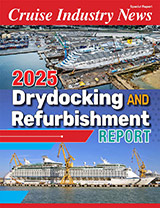The Panama Canal Authority (ACP) released second quarter (Q2) operational metrics today for fiscal year (FY) 2008. Total Canal transits and tonnage dropped slightly in Q2, but transits of passenger and dry bulk segments increased significantly. These metrics are based on operations from January through March 2008, the second quarter of the ACP’s 2008 fiscal year, and are compared with Q2 of FY 2007.
Total Canal transits decreased 2 percent during Q2 – from 4,053 to 3,971 transits. Panama Canal/Universal Measurement System (PC/UMS) tonnage also dropped 2.6 percent – from 80.4 million PC/UMS tons to 78.4 million PC/UMS tons. Passenger transits increased 34.8 percent – from 92 to 124 transits – while dry bulk transits rose 6.7 percent, from 586 to 625 transits and dry bulk cargo tonnage increased 10.4 percent, from 12.3 to 13.5 million PC/UMS tons.
“The ACP is on strong operational and financial footing, and we anticipate continued steady progress with the Canal Expansion Program and other modernization projects. Work is advancing on-time and on-budget, and, in fact, some projects are moving ahead of schedule,” said ACP Vice President of Research and Market Analysis Rodolfo R. Sabonge. “The slight drop in total transits and tonnage during the second quarter can be attributed in part to the slowdown in the U.S. economy and the subsequent decrease in cargo shipments to and from U.S. ports via the Canal. However, we have seen growth in other segments.”
The number of containers, vehicle carriers, tankers and general cargo dropped when compared to figures for FY 2007. Refrigerated cargo transits slightly decreased, by 1.4 percent, but refrigerated cargo tonnage increased 1.1 percent – from 5.6 million PC/UMS tons to 5.7 million PC/UMS tons.
Canal Waters Time (CWT), the average time it takes a vessel to transit the Canal (including waiting time for passage), rose in Q2. A surge in arrivals within the waterway’s peak season (February – May) coinciding with maintenance work at the Pedro Miguel and Miraflores locks caused a 32.8 percent increase in average CWT – from 27.40 hours to 36.39 hours. CWT for booked vessels (those ships holding reservations) increased 17.9 percent – from 16.67 hours to 19.66 hours.
“Factors like weather conditions, maintenance work, the mix in vessels arriving and the impact of peak season have attributed to the rise in CWT,” said ACP Executive Vice President of Operations Manuel Benítez. “To reduce CWT, we implemented several measures, including adding more equipment and personnel, postponing non-critical maintenance work and increasing the number of slots for ships waiting to transit.”
The official accident rate increased slightly to 1.51 accidents per 1,000 transits during Q2. The accident rate during Q2 of FY 2007 was 1.23 accidents per 1,000 transits. An official accident is one in which a formal investigation is requested and conducted.
The use of the Canal’s modified booking system, which the ACP implemented February 1, remained relatively flat, decreasing from 96.26 percent to 94.23 percent.



